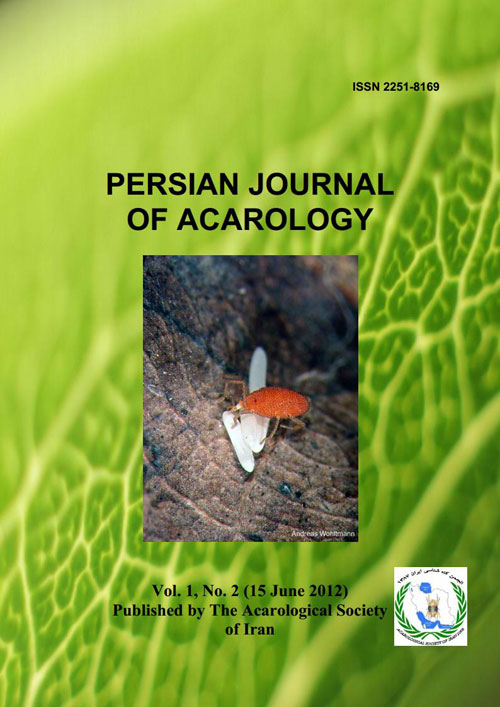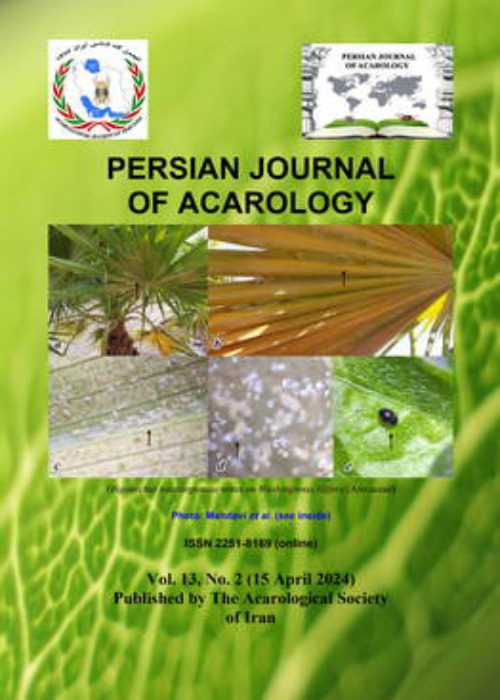فهرست مطالب

Persian Journal of Acarology
Volume:1 Issue: 2, Spring 2012
- تاریخ انتشار: 1391/08/30
- تعداد عناوین: 11
-
-
Page 57A study of the raphignathoid mite fauna of fields and orchards in Marand, Northwestern Iran, revealed two new species for the mite fauna of Iran, namely: Eustigmaeus ioaniensis Kapaxidi & Papadoulis, 1999 and Agistemus industani Gonzalez-Roodrigez, 1965 and six species for mites new for the fauna of East Azerbaijan province and eight species new for the mite fauna of Marand. Stigmaeidae with 13 species and Barbutiidae and Camerobiidae with one species each had the highest and the lowest number of identified species, respectively. A key to the Iranian families and genera of Raphignathoidea are included.Keywords: Acari, new records, Iran, Raphignathoidea, Marand, fields, orchards
-
Page 77A new species of the genus Stigmaeus Koch (Acari: Stigmaeidae), S. kermaniensis sp. nov. is described and illustrated. The new species was collected from soil under pistachio orchards, Pistacia vera (Linnaeaus), in Kerman province of Iran.Keywords: Acari, Stigmaeidae, Stigmaeus, new species, Iran
-
Page 85Aegyptobia pavlovskii is redescribed from new materials collected in Iran. This species is a new record for the false spider mite fauna ofIran. Additionally two new host records from the family Rosaceae are reported for this species.Keywords: Aegyptobia, redescription, new record, host record, Kerman
-
Page 93The subgenus Allositeroptes Livshits, Mitrofanov and Sharonov, 1986 of the genus Siteroptes Amerling (Acari: Pygmephoridae) is considered as junior synonym of Krczaldania Sasa, 1961 stat. nov. The subgenus Krczaldania Sasa, 1961 is redefined and elevated to a generic rank. The type species of the genus Krczaldania - Pygmephorus primitivus Krczal, 1959, is redescribed based on material from Crimea, Ukraine. A key to the known species of the genus Krczaldania is provided.Keywords: Pygmephoridae, Krczaldania, new synonyms, redescription
-
Page 101In this study, seven oppiid mite species (Oribatida: Oppiidae) belonging to six genera identified from Shendabad region (East Azerbaijan province, north-westernIran), of which one genus, one subgenus, six species and one subspecies are new records for mite fauna ofIran. Some of their morphological features and distributions in the world are presented. A key to the subfamilies and genera of Shendabad region is given.Keywords: mite, fauna, Shendabad, East Azerbaijan province, new records
-
Page 109The mite species Erythraeus (Zaracarus) coleopterus sp. nov. (Acari: Parasitengona: Erythraeidae) associated with a scarabaeid beetle is described from Iran. This is the first record of association between mites of the genus Erythraeus and beetles.Keywords: mite, beetle, Erythraeus (Zaracarus) coleopterus sp. nov., Scarabaeidae, Parasitengona
-
Page 119Between March 2004 and May 2005, 16 species of mites belonging to the suborders Prostigmata and Oribatida, and order Mesostigmata were found in wheat, barley, beet pulp and cottonseed meal (in the residue from, for example, the floor, equipment and the outside of sacks) in five factories producing food for domesticated animals. Mites were not found in samples of maize and bran collected. The factories are all in the Karaj region of Alborz Province in Iran.Keywords: mites, fauna, Oribatida, Mesostigmata, Prostigmata
-
Page 127
The genus Ornithodoros is worldwide distributed and features 113 known species. However, some species are rare and collections are scarce. The present paper expands the known distribution of two species of soft ticks, O. rondoniensis and O. marinkellei, by about 1400 km to the east, in caves in two municipal districts in the state of Pará, northern Brazil. These species were previously known only from the western Brazilian Amazon. Furthermore, some morphological details and molecular analysis are shown.
Keywords: Acari, Ixodida, Argasidae, cave, new records -
Page 137Population density and spatial distribution pattern of Eotetranychus frosti (McGregor) was determined in an unsprayed apple orchard of Kermanshah, Western Iran, from 31st May till 7th November 2007. On each sample date 130 leaves were selected, with a relative variation of 4.31%. Different methods of indices of dispersion, regression models (Taylor and Iwao), Morisitas index and Lloyds mean crowding to mean was used to determine the spatial distribution pattern of this mite. The mean population density of this mite per leaf was 2.079. The highest population density of E. frosti was in 9th August (4.938 per leaf). Index of dispersion (S2/m= 6.516), aggregation index (1/k= 2.653) and Lloyds mean crowding to mean (m*/m=3.653) showed an aggregated distribution for this species. The Taylor's power law and Iwao's patchiness regression methods showed aggregated spatial distribution too. Some changes in spatial distribution pattern from aggregated to random were observed using Morisitas index in different sampling dates. Three different coefficients of Taylor, Iwao and K were used to optimize the sample size for future studies. The lowest optimized sample size (34.70) was obtained by using the Taylor's coefficients. Spatial distribution parameters of E. frosti can be used to improve a sampling program of this mite in a framework of an integrated pest management system.Keywords: Eotetranychus frost, population density, spatial distribution, optimum sample size
-
Page 147In this study, the life history and demographic parameters of Histiostoma feroniarum (Defour) on Fusarium graminearum Clade were studied under laboratory condition. The incubation, larval and nymphal periods and longevity of adults were observed to be 1.6, 2.56, 3.09 and 10.48 days, respectively. The sex ratio was 0.65. Pre-oviposition, oviposition and post-oviposition periods lasted 1.8, 8.27 and 0.66 days, respectively. The gross reproductive rate (GRR), net reproductive rate (R0), intrinsic rate of increase (rm), finite rate of increase (λ), mean generation time (T) and doubling time (DT) were calculated to be 110.56 females/female, 23.54 females/ female, 0.195 day-1, 1.215 day-1, 16.23 days and 3.55 days, respectively. The results of this study reveal high potential of H. feroniarum as a major pest of laboratory cultures.Keywords: Histiostoma feroniarum, Fusarium graminearum, Life table, Population growth, Reproduction
-
First record of the Premicrodispus lineatus (Mahunka, 1986) (Acari: Heterostigmatina, Microdispidae) from IranPage 157


